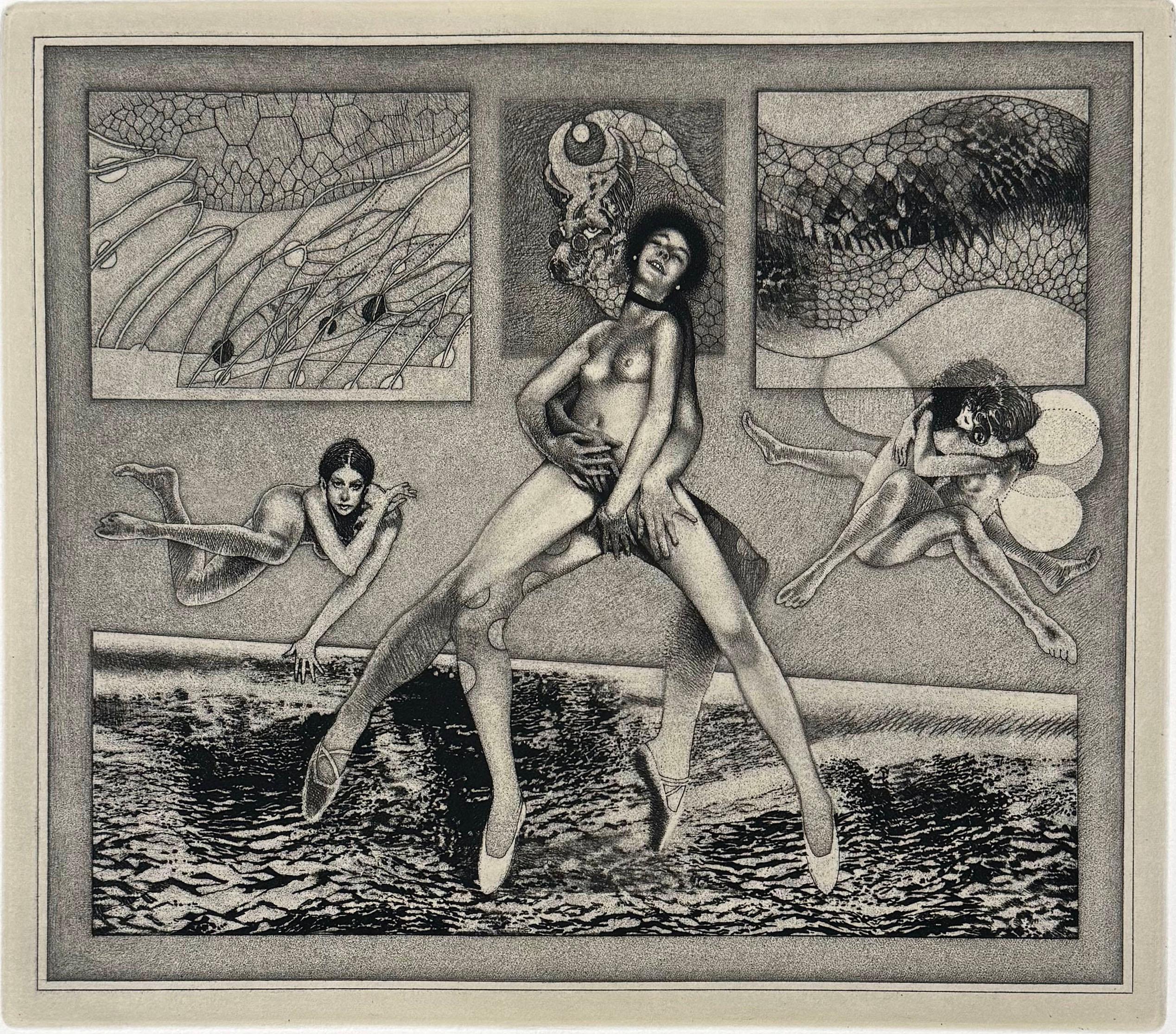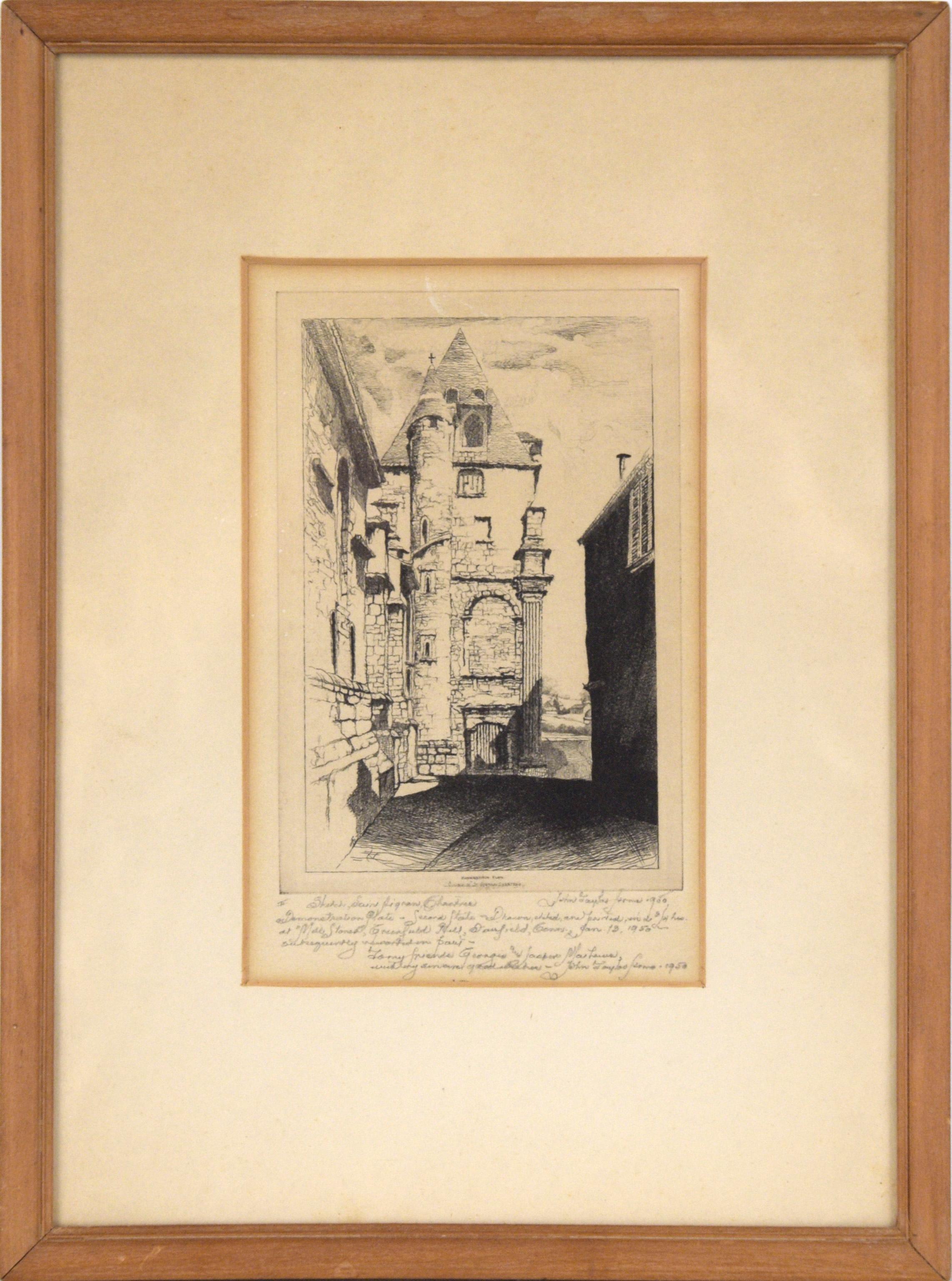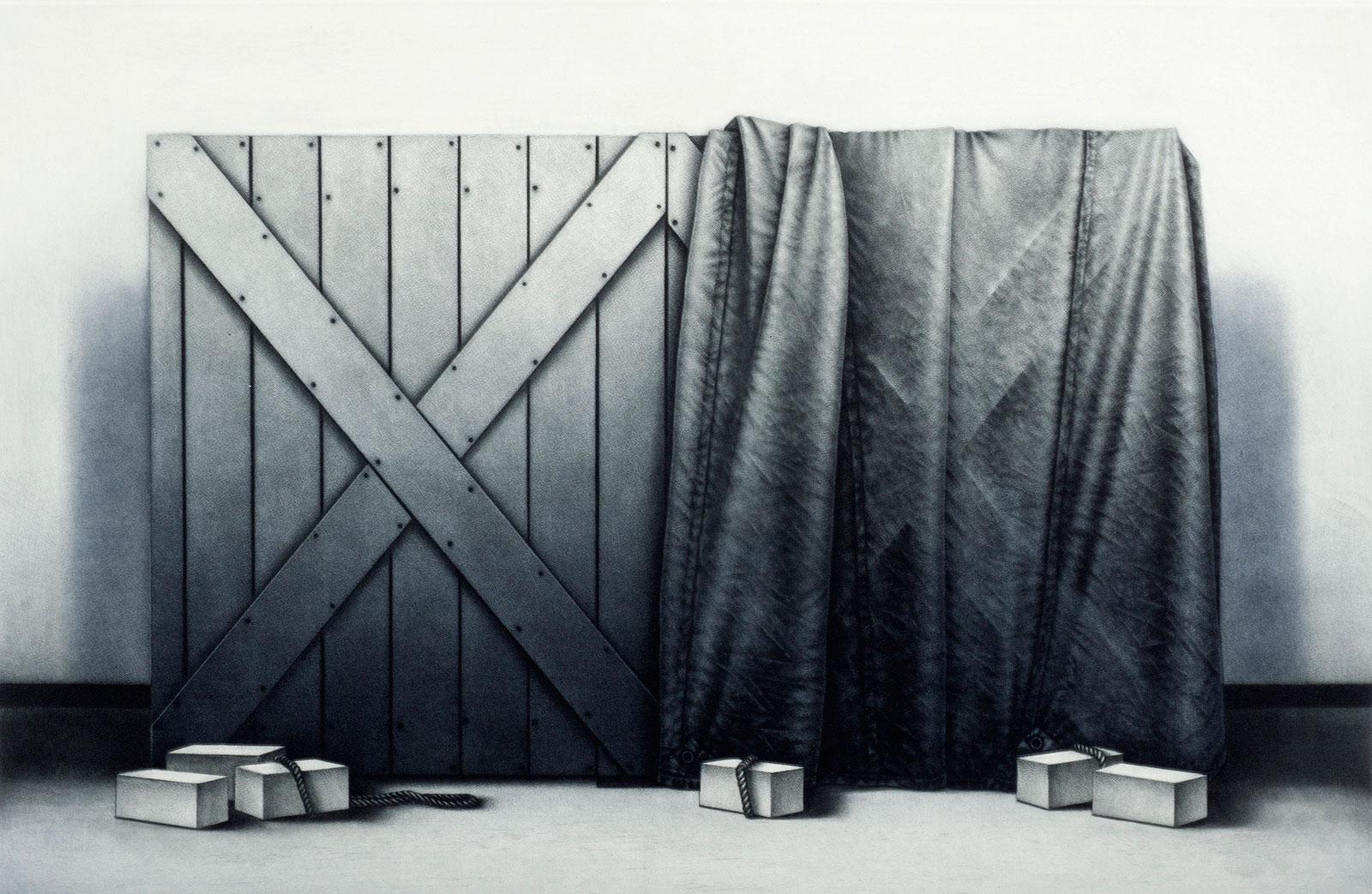Items Similar to Three 19th C. Engravings of Classical Italian Bronze Architectural Elements
Want more images or videos?
Request additional images or videos from the seller
1 of 20
UnknownThree 19th C. Engravings of Classical Italian Bronze Architectural Elements1889
1889
About the Item
A grouping of three engravings depicting classical Italian architectural features held in the National Museum of Naples, entitled "Bronze Hydria", "Marbre Naissance de Bacchus" and "Bronze Trepied Pour Sacrifice" from "Specimens from the Naples Museum : one hundred and sixty-eight plates, engraved on copper by the best Italian artists, illustrating four hundred and sixty-six objects from every branch of art and archaeology", published in Naples in 1889. These were created by artists F. Mori, P. Amendole and R. Radente.
"Marbre Naissance de Bacchus", Fig. 68: Top; The ancient Greek "Gaeta" Vase which depicts in bas-relief Mercury giving the infant Bacchus to the nymph Nisa. Bottom; A large vat adorned with bas-reliefs of Jupiter with his eagle, Hercules with his club, Mercury with his caduceus are visible and around other portions of the structure but not visible are Mars with a lance, Apollo with a lyre, Aesculapius with his staff and serpent and Bacchus with thyrsus and cantharus.
"Bronze Trepied Pour Sacrifice", Fig. 120 A beautiful tripod with three lion-footed legs capped by a seated sphinx and adorned with decorative arabesques and bearded heads of Jupiter Ammon. The legs are braced by elegant sprays of lotus and a lotus bud. The tripod is also called the Tripod of Isis and was meant for the worship of the Egyptian god Isis. It was found in a private house in Herculaneum.
"Bronze Hydria", Fig. 144 A pail richly embossed and inlaid in silver. The handles are hinged and form a rim to the pail when they are in the down position. One of the handles has the inscription " Corneliae S. Chelidonis".
The prints are presented in identical gold-colored wood frames with decorative textured gold-colored mats and gold fillets. Each frame measures 14.75" x 12.5" x 2".
- Creation Year:1889
- Dimensions:Height: 14.75 in (37.47 cm)Width: 12.5 in (31.75 cm)Depth: 2 in (5.08 cm)
- Medium:
- Period:
- Condition:
- Gallery Location:Alamo, CA
- Reference Number:
About the Seller
5.0
Platinum Seller
These expertly vetted sellers are 1stDibs' most experienced sellers and are rated highest by our customers.
Established in 2011
1stDibs seller since 2019
230 sales on 1stDibs
Typical response time: 1 hour
- ShippingRetrieving quote...Ships From: Alamo, CA
- Return PolicyA return for this item may be initiated within 7 days of delivery.
More From This SellerView All
- "Inspection Tour in the Wine Vaults", 1876 Philadelphia Centennial ExpositionLocated in Alamo, CAThis engraving is entitled "Philadelphia, PA- The Centennial Exposition - the Jury of Award on an Inspection Tour in the Wine Vaults of Agricultural Hall", ...Category
Late 19th Century Naturalistic Interior Prints
MaterialsEngraving
- The Heidelberg Tun: A Framed 17th Century Engraving of a Huge Wine CaskLocated in Alamo, CA"The Heidelberg Tun" is a 17th century engraving by an unknown artist. It depicts a famous huge ornamental wine cask that resided in the wine cellar of Heidelberg Castle. The cask shown here, built in 1664, is the second of four Heidelberg Tuns; the first was destroyed during the Thirty Years' War, between 1618 and 1648. This cask was built in 1664 when Karl Ludwig ordered Heidelberg cellar master...Category
Late 17th Century Old Masters Interior Prints
MaterialsEngraving
- Set of Two 18th Century Engravings from William Hogarth's "Analysis of Beauty"By William HogarthLocated in Alamo, CAThe two plates in this set were created utilizing both engraving and etching techniques by William Hogarth in 1753, originally as illustrations of his book on aesthetics, entitled "Analysis of Beauty". Due to their popularity, these plates were later published separately. The publication line in the lower right reads: "Designed, Engraved, and Publish'd by Wm. Hogarth, March 5th 1753, according to Act of Parliament." Hogarth's original copper plates were refurbished where needed by James Heath and engravings were republished in London in 1822 by Braddock, Cradock & Joy. This was the last time Hogarth's copper plates were used for printing. Most were melted during World War I for the construction of bombs. These large folio sized "Analysis of Beauty" engravings are presented in antiqued gold-colored frames with double mats; the outer silk mats are light brown-colored and the inner mats are dark brown. Each frame measures 27.38" x 31.25" x 1.13". There is one tiny spot in the right margin of plate 1 and another in the lower margin; the latter could be from the printing process. The prints are otherwise in excellent condition. The "Analysis of Beauty" series is in the collection of many major museums, including: The British Museum, The Metropolitan Museum of Art, The Tate Museum, The Chicago Art Institute and The Fine Arts Museums of San Francisco. The first engraving (Plate 1) depicts a courtyard of statues which is filled with some of the most famous works of classical sculpture. The most important sculptures are surrounded by less impressive works. The Medicean Venus (#13) is in the center with a statue of Julius Caesar (#19) to the right, elevated on a pulley with a short, overdressed Brutus stands over the falling Caesar. The Apollo Belvedere (#12) is next. A judge stands to the right with his foot on a cherub (#16). Another crying cherub holds a gallows and wipes his tears with the judge's robe. A sphinx (#21) and the drunken Silenus (#107) are below the Venus. Michaelangelo's torso (#54) and a statue of Antonius (#6) are seen in the foreground. The Farnese Hercules (#3) and a bust of another Hercules (#4) under two statuettes of Isis are also included in the scene. The key to these objects is included in the form of a serpentine line winding around a cone (#26), Hogarth's "Line of Beauty". For Hogarth the winding line is an essential element of beauty in art. Hogarth's theory of beauty is communicated in this plate. Plate 2 is thought to represent the Wanstead Assembly, with the Earl of Tynley and his household. It is an adaptation of a scene in the Happy Marriage series, which complements Hogarth's Marriage à la Mode...Category
Mid-18th Century Old Masters Interior Prints
MaterialsEtching, Engraving
- "Inside of a House in Nootka Sound" (Canada) from Captain Cook's 3rd VoyageBy John WebberLocated in Alamo, CA"The Inside of a House in Nootka Sound" is an engraving created by William Sharp (1749-1824), from a drawing by John Webber (1752-1793), who was the artist on Captain James Cook's 3rd and final voyage of discovery. It is Plate 65 in "A Voyage to the Pacific Ocean Undertaken by the Command of His Majesty, for Making Discoveries in the Northern Hemisphere", the official British Admirality sanctioned journal published upon completion of the voyage in London in 1784 by Strahan & Cadell. This engraving is presented in a Koa wood frame and a white mat. There are occasional tiny faint spots, but the print is otherwise in very good condition. Koa wood is legendary in Hawaii. Not only is this amazing wood native to Hawaii, but it is known for the deep rich colors and varied grain pattern. Koa has an honored heritage in Hawaii and is highly revered and sacred. The word “koa” means “warrior” in Hawaiian. The warriors of King Kamehameha the Great, created canoes and weapons from a wood plentiful on the Big Island of Hawaii. This wood became synonymous with the warriors themselves, and it became known as koa. There are three other engravings listed form the official journal of Captain Cook's 3rd voyage available that are presented in identical Koa wood frames and mats. They would make a wonderful grouping for a display of 2, 3 or 4 prints. Please see listings: LU117324682432, LU117324684022, LU117324684062. A discount is available for a grouping depending on the number of items included. Nootka Sound is on the west coast of Vancouver Island, British Columbia, Canada. It was explored by Captain Cook in 1778 after he discovered Hawaii during his 3rd voyage. He originally named it King George's Sound, but did record Nootka Sound, which he thought was its native name. Hawaii was originally called The Sandwich Islands in honor of The Earl of...Category
1780s Realist Interior Prints
MaterialsEngraving
- "King of the Friendly Islands" (Tonga); Engraving from Captain Cook's 3rd VoyageBy John WebberLocated in Alamo, CA"Poulaho, King of the Friendly Islands, Drinking Kava" is an engraving created by William Sharp (1749-1824), from a drawing by John Webber (1752-1793), who was the artist on Captain James Cook's 3rd and final voyage of discovery. It was published in the atlas of "A Voyage to the Pacific Ocean Undertaken by the Command of His Majesty, for Making Discoveries in the Northern Hemisphere", the official British Admirality sanctioned journal published upon completion of the voyage in London in 1784 by Strahan & Cadell. Captain Cook visited Tonga on his 3rd voyage, which he named The Friendly Islands because of the warm welcome he and his crew received, unlike some of the other more hostile Pacific islands. The engraving depicts Cook and his men observed a kava ceremony at the village of Mu’a on Tongatapu. King Paulaho sits in the centre foreground, his back to the spectator with a man kneeling before him. The ceremonial mat depicted behind Paulaho indicates that nobody was allowed to sit behind him. The figure in the centre holds a single cup, referring to the Tongan custom of offering the cup to the king first. Kava is native to the islands of the South Pacific and was first described for English readers in 1768 by Captain James Cook. The kava root has been used for centuries as a central feature of ceremonies and celebrations because it was able to bring about a calming and pleasant social atmosphere. The root was crushed and processed into coconut milk to become the focal ceremonial beverage, simply referred to as kava. This engraving is presented in a Koa wood frame and a white mat. Koa wood is legendary in Hawaii. There are occasional faint spots, but the print is otherwise in very good condition. This amazing Koa wood is native to Hawaii and it is known for the deep rich colors and varied grain pattern. Koa has an honored heritage in Hawaii and is highly revered and sacred. The word “koa” means “warrior” in Hawaiian. The warriors of King Kamehameha the Great, created canoes and weapons from a wood plentiful on the Big Island of Hawaii. This wood became synonymous with the warriors themselves, and it became known as koa. There are three other engravings listed from the official journal of Captain Cook's 3rd voyage available that are presented in identical Koa wood frames and mats (LU117324682422, LU117324684052, LU117324684032). They would make a wonderful grouping for a display of 2, 3 or 4 prints. A discount is available for a grouping depending on the number of items included. Captain Cook is remembered as one of the greatest explorers and navigators in history. His explorations included Australia, New Zealand and islands of the South Pacific and the northwest coast of North America. Hawaii was discovered by Captain Cook during this voyage. Hawaii was originally called The Sandwich Islands in honor of The Earl of Sandwich...Category
1780s Realist Figurative Prints
MaterialsEngraving
- Four 19th Century Hand Colored Engravings Depicting English Royal ResidencesBy Charles WildLocated in Alamo, CAFour hand colored etchings and aquatints depicting interiors within English royal residences, including "The Blue Velvet Room at Carlton House", "The Queen's Library at Frogmore", "T...Category
1810s Academic Interior Prints
MaterialsEngraving
You May Also Like
- Europa, by Peter MiltonBy Peter MiltonLocated in Palm Springs, CAResist Ground Etching and Engraving from a Copper Plate on BFK Rives, Somerset Buff, Wove Paper Medium: Resist Ground Etching & Engraving Edition of 125 Year: 1982 One o...Category
1980s Contemporary Interior Prints
MaterialsEtching, Engraving
- "Church of St. Aignan Chartres" Etching in Ink on Paper (Demonstration Plate)By John Taylor ArmsLocated in Soquel, CA"Church of St. Aignan Chartres" Etching in Ink on Paper (Demonstration Plate) Delicate and detailed drypoint etching of the Church of St. Aignan in Chartres, France by John Taylor Arms (American, 1887-1953). The viewer stands in an alley near the church, looking out of the shadows at the sunlit towers. The architectural details of the church are well-captured, including the texture of the stone walls, the roof, and ornamental detail. Titled, signed, dated, and inscribed along the bottom edge: Sketch, Saint Aignon, Chartres John Taylor Arms 1950 The inscription includes details about production, as well as a dedication "To my friends Georgia and Jasper Mathews, with my sincerest good wishes" Presented in a wood frame with an off-white mat. Frame size: 12.5"H x 9.25"W Image size: 7"H x 4.5"W John Taylor Arms was born in Washington, DC in 1887. He studied law at Princeton University, transferring to the Massachusetts Institute of Technology, Boston, to study architecture, graduating in 1912. After serving as an officer in the United States Navy during World War I, he devoted himself full-time to etching. He published his first original etchings in 1919. His initial subject was the Brooklyn Bridge in New York City near which he worked. Arms developed a successful career as a graphic artist in the 1920s and 1930s, specializing in series of etchings of Gothic churches and cathedrals in France and Italy. In addition to medieval subjects, Arms made a series of prints of American cities. He used sewing needles and magnifying glasses to get a fine level of detail. A member of many printmaking societies, Arms served as president of the Society of American Graphic Artists. An educator, Arms wrote the Handbook of Print Making and Print Makers (1934) and did numerous demonstrations and lectures. Arms was elected into the National Academy of Design as an Associate member in 1930, and became a full member in 1933. His work was also part of the painting event in the art competition at the 1932 Summer Olympics...Category
1940s Victorian Still-life Prints
MaterialsInk, Etching, Drypoint, Paper
- "Dark Box" Drypoint Etching with Aquatint (no. 10/20)Located in Soquel, CAFinely balanced etching by Benjamin Vasserman (Estonian, b 1949). A squash sits atop a small black box with a latch. There is a drapery behind the squa...Category
1980s Modern Interior Prints
MaterialsInk, Aquatint, Drypoint, Paper
- "Still Life with Door", Monochrome Cyan Drypoint EtchingBy Barbara B. CohnLocated in Soquel, CALimited edition monochrome cyan drypoint etching of a potted plant and door by Barbara Cohn (American, 1923-2019). Numbered ("2/25"), titled ("Still Life with Door"), and hand signed...Category
1980s American Realist Still-life Prints
MaterialsPaper, Ink, Drypoint
- In the Silence of Passing YearsBy Marc BalakjianLocated in New Orleans, LAThis image is an artist proof XII / XII. The artist's subject matter was enigmatic: a recurring theme was that of anonymous packages tied with knots of rope; sometimes there are prison bars...Category
Late 20th Century Contemporary Still-life Prints
MaterialsMezzotint
- Lillies and Bowls (still life of flowers and colorful bowls)Located in New Orleans, LAThe moon, bowls, lillies and birds are featured in this 2002 mezzotint. It is #17 from an edition of 75 and is signed, titled, dated and edition by hand by this Korean artist born i...Category
Late 20th Century Contemporary Still-life Prints
MaterialsMezzotint
Recently Viewed
View AllMore Ways To Browse
Antique Architectural Elements
Bronze Architecture
Four Engravings
Italian Wood Architectural Elements
Lion Footed
Bronze Head Italian
Italian Bronze Head
Bronze Framed Plate
19th Architecture Engraving
Antique Copper Still
Antique Copper Stills
Copper Still Antique
Bronze Head Classical
Framed Lotus
Italian Fig
Large Bas Relief
Bronze Sphinx
Apollo 19th





